Tracing determinants of dual substrate specificity in glycoside hydrolase family 5
- PMID: 22645145
- PMCID: PMC3408205
- DOI: 10.1074/jbc.M112.362640
Tracing determinants of dual substrate specificity in glycoside hydrolase family 5
Abstract
Enzymes are traditionally viewed as having exquisite substrate specificity; however, recent evidence supports the notion that many enzymes have evolved activities against a range of substrates. The diversity of activities across glycoside hydrolase family 5 (GH5) suggests that this family of enzymes may contain numerous members with activities on multiple substrates. In this study, we combined structure- and sequence-based phylogenetic analysis with biochemical characterization to survey the prevalence of dual specificity for glucan- and mannan-based substrates in the GH5 family. Examination of amino acid profile differences between the subfamilies led to the identification and subsequent experimental confirmation of an active site motif indicative of dual specificity. The motif enabled us to successfully discover several new dually specific members of GH5, and this pattern is present in over 70 other enzymes, strongly suggesting that dual endoglucanase-mannanase activity is widespread in this family. In addition, reinstatement of the conserved motif in a wild type member of GH5 enhanced its catalytic efficiency on glucan and mannan substrates by 175 and 1,600%, respectively. Phylogenetic examination of other GH families further indicates that the prevalence of enzyme multispecificity in GHs may be greater than has been experimentally characterized. Single domain multispecific GHs may be exploited for developing improved enzyme cocktails or facile engineering of microbial hosts for consolidated bioprocessing of lignocellulose.
Figures




Similar articles
-
Structure-Function Analysis of a Mixed-linkage β-Glucanase/Xyloglucanase from the Key Ruminal Bacteroidetes Prevotella bryantii B(1)4.J Biol Chem. 2016 Jan 15;291(3):1175-97. doi: 10.1074/jbc.M115.691659. Epub 2015 Oct 27. J Biol Chem. 2016. PMID: 26507654 Free PMC article.
-
A flexible loop for mannan recognition and activity enhancement in a bifunctional glycoside hydrolase family 5.Biochim Biophys Acta Gen Subj. 2018 Mar;1862(3):513-521. doi: 10.1016/j.bbagen.2017.11.004. Epub 2017 Nov 3. Biochim Biophys Acta Gen Subj. 2018. PMID: 29108954
-
Glycoside hydrolase subfamily GH5_57 features a highly redesigned catalytic interface to process complex hetero-β-mannans.Acta Crystallogr D Struct Biol. 2022 Nov 1;78(Pt 11):1358-1372. doi: 10.1107/S2059798322009561. Epub 2022 Oct 20. Acta Crystallogr D Struct Biol. 2022. PMID: 36322419
-
Donor and acceptor substrate selectivity among plant glycoside hydrolase family 32 enzymes.FEBS J. 2009 Oct;276(20):5788-98. doi: 10.1111/j.1742-4658.2009.07316.x. Epub 2009 Sep 17. FEBS J. 2009. PMID: 19765078 Review.
-
Relationship of sequence and structure to specificity in the alpha-amylase family of enzymes.Biochim Biophys Acta. 2001 Mar 9;1546(1):1-20. doi: 10.1016/s0167-4838(00)00302-2. Biochim Biophys Acta. 2001. PMID: 11257505 Review.
Cited by
-
Dynamics of loops surrounding the active site architecture in GH5_2 subfamily TfCel5A for cellulose degradation.Biotechnol Biofuels Bioprod. 2023 Oct 18;16(1):154. doi: 10.1186/s13068-023-02411-2. Biotechnol Biofuels Bioprod. 2023. PMID: 37853500 Free PMC article.
-
Unraveling the roles of coastal bacterial consortia in degradation of various lignocellulosic substrates.mSystems. 2023 Aug 31;8(4):e0128322. doi: 10.1128/msystems.01283-22. Epub 2023 Jul 7. mSystems. 2023. PMID: 37417747 Free PMC article.
-
Enhancement of synthetic Trichoderma-based enzyme mixtures for biomass conversion with an alternative family 5 glycosyl hydrolase from Sporotrichum thermophile.PLoS One. 2014 Oct 8;9(10):e109885. doi: 10.1371/journal.pone.0109885. eCollection 2014. PLoS One. 2014. PMID: 25295862 Free PMC article.
-
The evolutionary origins of detoxifying enzymes: the mammalian serum paraoxonases (PONs) relate to bacterial homoserine lactonases.J Biol Chem. 2013 Aug 16;288(33):23914-27. doi: 10.1074/jbc.M112.427922. Epub 2013 Jun 20. J Biol Chem. 2013. PMID: 23788644 Free PMC article.
-
Ligand-binding specificity and promiscuity of the main lignocellulolytic enzyme families as revealed by active-site architecture analysis.Sci Rep. 2016 Mar 24;6:23605. doi: 10.1038/srep23605. Sci Rep. 2016. PMID: 27009476 Free PMC article.
References
-
- Nobeli I., Favia A. D., Thornton J. M. (2009) Protein promiscuity and its implications for biotechnology. Nat. Biotechnol. 27, 157–167 - PubMed
-
- Khersonsky O., Tawfik D. S. (2010) Enzyme promiscuity: a mechanistic and evolutionary perspective. Annu. Rev. Biochem. 79, 471–505 - PubMed
-
- Peisajovich S. G., Tawfik D. S. (2007) Protein engineers turned evolutionists. Nat. Methods 4, 991–994 - PubMed
-
- Khersonsky O., Roodveldt C., Tawfik D. S. (2006) Enzyme promiscuity: evolutionary and mechanistic aspects. Curr. Opin. Chem. Biol. 10, 498–508 - PubMed
-
- Khersonsky O., Tawfik D. S. (2006) The histidine 115-histidine 134 dyad mediates the lactonase activity of mammalian serum paraoxonases. J. Biol. Chem. 281, 7649–7656 - PubMed
Publication types
MeSH terms
Substances
LinkOut - more resources
Full Text Sources
Other Literature Sources

